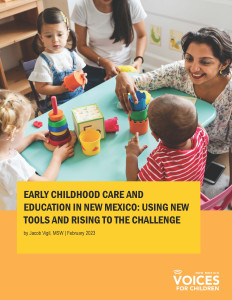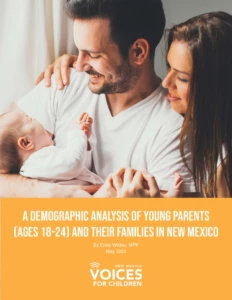Cradle-to-Career Education
Children are our most valuable natural resource, and the investments we make in them, particularly in their earliest years, will benefit us all in the long term. Every family and individual should have access to an affordable, evidence-based, and high-quality prenatal and cradle-to-career system of care and education. Investing in a life-long educational continuum is the most effective way to ensure that New Mexicans have the best opportunities to succeed in school and throughout life.
Featured Content

KIDS COUNT County Fact Sheets
Some New Mexico counties have access to a greater variety of economic opportunities for families as well as support services and programs to help them thrive. By highlighting data by county, we can discover varying needs for improvement in our systems and policies to reach every community and to improve child and family well-being. (State- and county-level data on child population by race, ethnicity and age group, and 18 indicators of child well-being.)
 Early Childhood Care and Education in New Mexico: Using New Tools and Rising to the Challenge
Early Childhood Care and Education in New Mexico: Using New Tools and Rising to the Challenge
New Mexico has expanded early childhood programs and the voters have mandated even more. This report looks at the still-unmet need as well as the science behind these programs. (State-level data on child well-being and unmet early childhood needs.)
 A Demographic Analysis of Young Parents (Ages 18-24) and Their Families in New Mexico
A Demographic Analysis of Young Parents (Ages 18-24) and Their Families in New Mexico
Young parents make up a very small share of New Mexico’s population and they face unique challenges and barriers to success. This report looks at how this subpopulation is faring. (State-level data on the demographics of parents and young adults on indicators such as economic security, educational attainment, etc.)
Recent Publications
2024 New Mexico KIDS COUNT Data Book
NM KIDS COUNT Data Book Child well-being continues improving in New Mexico, thanks to investments by our lawmakers. This annual report provides data on numerous child well-being indicators related to economic security, education, health, and family and community, and includes policy solutions. (State-, county-, tribal- and school district-level data on child well-being.)
New Mexico KIDS COUNT County Fact Sheets
County Fact Sheets Some counties have access to a greater variety of economic opportunities and support services. By highlighting data by county, we can discover varying needs for improvement in our systems and policies. (State- and county-level data on child population by race, ethnicity and age group, and 18 indicators of child well-being.)
Recent Blog Posts
Support New Mexico’s Kids, Not Billionaires
By Paige Knight May 16, 2025 New Mexico’s kids [...]
New Mexico Voices for Children Releases 2024 New Mexico KIDS COUNT Data Book
January 21, 2025 As child advocates, we strive for [...]
Recent News Coverage
Once again, N.M. ranks 50th for kids; this must change
Santa Fe New Mexican--New Mexicans are a people of strength, resilience and deep-rooted pride — shaped by our commitment to community and our dedication to the well-being of families. That’s why it’s painful to reconcile our values with the news in this week’s release of state rankings on child well-being from the Annie E. Casey Foundation’s annual Kids Count Data Book. Once again, New Mexico is ranked 50th. Two things are true: Progress takes time — and our children can’t afford to wait.
Let’s Use Childcare Assistance to Lift the Workers Out of Poverty Too
El Semanario--While it’s great to know that the expansion of universal child care has such a dramatic effect on lowering poverty in New Mexico for the children and families who receive the program, there is one significant way in which the CA program falls short: wages for child care and other early care and education (ECE) workers remain unacceptably low. If we can use our CA program to lift kids and families out of poverty, why don’t we use it to lift the people who provide that care out of poverty as well?
Programs, Coalitions & Networks
Transform Education NM Formed in response to the hallmark Yazzie/Martinez v State of New Mexico lawsuit, TENM works to center student equity in our K-12 system and to ensure that our communities are leading the way to fundamentally reimagining and transforming our schools. Its platform advocates for a public education system that: embraces and incorporates the cultural and linguistic heritage of our diverse communities as a foundation for all learning; provides extended learning opportunities; values our teachers and educators; allows all children to access early learning programs; offers services such as counseling and health clinics to promote learning; and ensures our schools receive the financial resources required to meet the needs of all children.
New Mexico Civic Engagement Table A project of the Center for Civic Policy, NMCET unifies more than 40 diverse organizations from different sectors around a common agenda to strengthen our democracy. Among its issues are economic justice, early childhood education, climate justice, immigration reform, and economic development.
Invest in Kids NOW! is the coalition behind the decade-long push to allow New Mexico voters to decide whether to distribute a tiny share of the state’s multi-billion dollar Land Grant Permanent School Fund in order to expand education and care programs for the state’s youngest children. With the passage of that initiative in 2022, with 70% of New Mexico voters in favor, the coalition continues to work to ensure that programs and services for children from birth to age five are high quality and fully funded, and that early educators are paid family-sustaining wages.
Resources
The Early Childhood Map Gallery is a collection of interactive maps and applications describing early childhood risks, services, and resources in New Mexico neighborhoods by the NM Community Data Collaborative.
Change the First Five Years and You Change Everything is a short video by the Ounce of Prevention Fund that puts a human face on the need for higher quality ECE programs, particularly for children from low-income homes.
The Heckman Equation is an online resource for policymakers, advocates and organizations who promote investment in early childhood education and development. The site, based on the work of Nobel laureate in economics, James Heckman, includes short videos and other advocacy tools.
Zero to Three is a national, nonprofit organization that informs, trains, and supports professionals, policy-makers, and parents in their efforts to improve the lives of infants and toddlers.
Fight Crime: Invest in Kids is a national, bipartisan, nonprofit anti-crime organization of more than 5,000 police chiefs, sheriffs, prosecutors, attorneys general, and other law enforcement leaders, who advocate for high-quality early care and education programs as one way to reduce crime.
Mission: Readiness is a nonprofit, non-partisan organization led by senior retired military leaders ensuring continued national security and prosperity by calling for smart investments, including high-quality early care and education programs, in the upcoming generation of American children.
